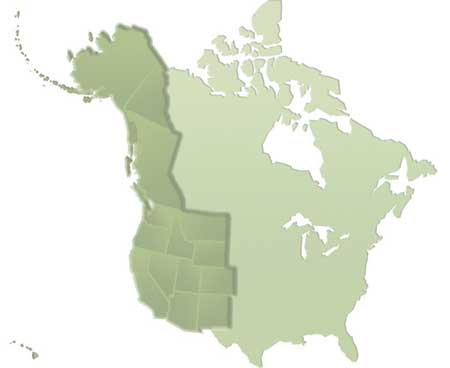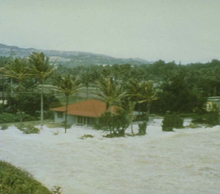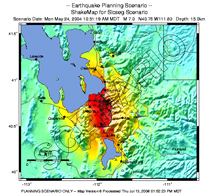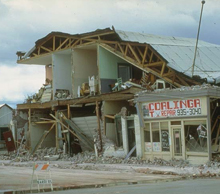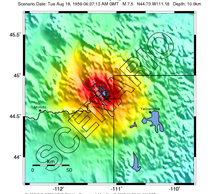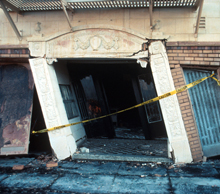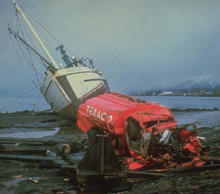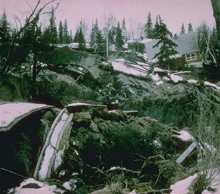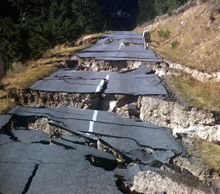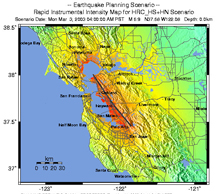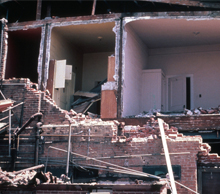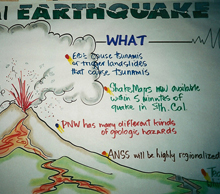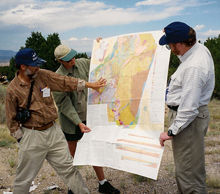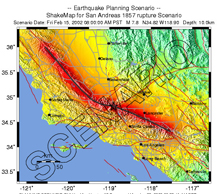Oregon Earthquake Hazard Mitigation Legislation
(OR‐1) Oregon Revised Statutes 401.025‐.335 (Emergency Management and Services): Establishes Oregon Office of Emergency Management and describes agency responsibilities.
(OR‐2) Oregon Revised Statutes 516: Added natural hazard mitigation to the enabling statute for the Department of Geology and Mineral Industries.
(OR‐3) Oregon Revised Statutes 336.071: Requirement for earthquake education and tsunami drills to be conducted in public schools.
(OR‐4) Oregon Revised Statutes 455.448: Provisions for entry and inspection of buildings damaged by earthquakes.
(OR‐5) Oregon Revised Statutes Chapter 455: Building Code: All buildings in Oregon must conform to the state’s codes, which influences the way buildings are constructed with respect to seismic risk, wind, snow, wildfire, and flood hazards. Oregon State Building Codes (Seismic): The One and Two Family Dwelling Code and the Structural Specialty Code (both included in the State Building Code) contain maps identifying the various seismic zones for Oregon, as described in Section 2 of this guide. The Structural Specialty Code is based on the 1997 edition of the Uniform Building Code published by the International Conference of Building Officials and amended by the state of Oregon. The Uniform Building Code contains specific regulations for development within seismic zones. Within these standards are six levels of design and engineering specifications that are applied to areas according to the expected degree of ground motion and site conditions that a given area could experience during an earthquake (ORS 455.447).
The Structural Code requires a site‐specific seismic hazard report for projects including essential facilities such as hospitals, fire and police stations, emergency response facilities, and special occupancy structures, such as large schools and prisons. The seismic hazard report required by the Structural Code for essential facilities and special occupancy structures must take into consideration factors such as the seismic zone, soil characteristics including amplification and liquefaction potential, any known faults, and potential landslides. The findings of the seismic hazard report must be considered in the design of the building. The Dwelling Code simply incorporates prescriptive requirements for foundation reinforcement and framing connections based on the applicable seismic zone for the area. The cost of these requirements is rarely more than a small percentage of the overall cost for a new building. The requirements for existing buildings vary depending on the type and size of the alteration and whether there is a change in the use of the building to house a more hazardous use. Oregon State Building Codes recognize the difficulty of meeting new construction standards in existing buildings and allow some exception to the general seismic standards. Upgrading existing buildings to resist earthquake forces is more expensive than meeting code requirements for new construction. State code only requires seismic up‐grades when there is significant structural alteration to the building or where there is a change in use that puts building occupants and the community at a greater risk. Your local building official is responsible for enforcing these codes. Although there is no statewide building code for substandard structures, local communities have the option of adopting one to mitigate hazards in existing buildings. The state has adopted regulations to abate buildings damaged by an earthquake in Oregon Administrative Rules (OAR) 918‐470. Oregon Revised Statutes (ORS) 455.020 and 455.390‐400 also allow municipalities to create local programs to require seismic retrofitting of existing buildings within their communities. The building codes do not regulate public utilities and facilities constructed in
public right‐of‐ways, such as bridges that are regulated by the Department of Transportation.
For more information on state building codes contact the Oregon Department of Consumer and
Business Services – Building Codes Division. The Building Codes Division of Oregon’s Department of
Consumer and Business Services is responsible for administering statewide building codes. Its
responsibilities include adoption of statewide construction standards that help create disaster‐resistant buildings, particularly for flood, wildfire, wind, foundation stability, and seismic hazards. Information about wildfire‐related building codes is found through this department.
(OR‐6) Oregon Revised Statutes 401.337 Oregon Seismic Safety Policy Advisory Commission: OSSPAC is a state advisory commission created in February 1990 through an executive order from Governor Neil Goldschmidt and established in statute by the 1991 Oregon Legislature (ORS 401.337). It is made up of 18 members with interests in earthquake safety: Building Codes Division, Oregon Emergency Management, Department of Geology and Mineral Industries, Department of Land Conservation and Development, Oregon Department of Transportation, two representatives from the Oregon Legislature, one local government representative, one member from education, three from the general public and six members from affected industries, such as homebuilders and banking industries. The purpose of the work of OSSPAC is to reduce exposure to Oregon’s earthquake hazards by: developing and influencing
policy at the federal, state, and local government levels; facilitating improved public understanding and encouraging identification of earthquake risk; and supporting research and special studies, appropriate mitigation and response and recovery.
(OR‐7) Oregon Senate Bill 96 (1991): Seismic Hazard Investigation‐Requires site‐specific seismic hazard investigations before the construction of essential facilities, hazardous facilities, major structures, and special‐occupancy structures (e.g., hospitals, schools, utilities and public works, police and fire stations). These requirements are adopted into the State Building Code. The law also provides for the installation of strong‐motion sensors in selected major buildings and mandates that school officials in all public schools lead students and staff in earthquake drills (ORS 455.447 and 336.071).
(OR‐8) Senate Bill 1057 (1995): Created a task force to evaluate the risks impacting existing buildings and make recommendations to the 1997 Oregon Legislative Assembly.
(OR‐9) Oregon House Bill 3144 (1999) Created a new category of engineering license in Oregon, structural engineer for the design of significant structures. The legislation specifically required engineering for buildings housing hazardous occupancies, special occupancy structures as defined in ORS 455.447, essential facilities greater than 4000 square feet and 20 feet in height, and irregular structures as defined by the State Building Code, to be performed by a structural engineer. The legislation did not amend the architects’ law allowing them to continue to design these structures.
(OR‐10) Oregon Senate Bill 13 (2001): Seismic Event Preparation: Requires state and local agencies to hold annual drills instructing employees on earthquake emergency procedures. Requires employers with 250 or more full time employees to hold annual drills instructing employees on earthquake emergency procedures. Requires Oregon Emergency Management to adopt rules governing required earthquake emergency drills. Implement mandatory earthquake drills for state agencies. “Drop, cover, and hold” or other protective action is critical in reducing injury and loss of life in the workplace and home during an earthquake. The more people practice the drill, the better they will respond to a real event. Voluntary drills will never be enough. State agencies are setting an example by conducting a drill annually. Requires state and local agencies, and private sector employers with 250 or more employees to hold annual drills instructing employees on earthquake emergency procedures.
(OR‐11) Oregon Senate Bill 14 (2001) Seismic Surveys for School Buildings: Requires that the State Board of Education examine buildings used for both instructional and non‐instructional activities, including libraries, auditoriums, and dining facilities, and that DOGAMI use the surveys to make an initial evaluation of each building in order to determine which buildings are in most need of additional analysis. Following the identification of high‐risk buildings and additional analysis, high‐risk buildings must be rehabilitated by January 1, 2032, subject to available funding. Senate Joint Resolutions 21 and 22 are bond measures (November 2002 election) which would provide funding to implement this proposed action. Subject to the provision of funding, the Oregon Department of Education and Oregon University System are to conduct seismic surveys of buildings that have a capacity of 250 or more and are routinely used for student activities. Requires the surveys to be completed by January 1, 2007, and provides that the surveys be conducted in accordance with FEMA publication, Rapid Visual Screening of Buildings for Potential Seismic Hazards (FEMA‐154). Requires State Board of Education to examine buildings used for both instructional and non‐instructional activities, including libraries, auditoriums, and dining facilities. It requires DOGAMI to use the surveys to make an initial evaluation of each building in order to determine which buildings are in most need of additional analysis. Following the identification of high‐risk buildings and additional analysis, high‐risk buildings must be rehabilitated by January 1, 2032, subject to available funding pursuant to Senate Joint Resolutions 21 and 22.
(OR‐12) Oregon Senate Bill 15 (2001) Seismic Surveys for Hospital Buildings: Requires Oregon Health Division, subject to provision of funding from gifts, grants, and donations, to provide for seismic safety surveys of certain hospital buildings. Subject to available funding from gifts, grants, and donations, requires seismic safety surveys of fire stations and law enforcement facilities. Requires fire departments or districts, law enforcement agencies, and certain hospital facilities, after consultation with DOGAMI, to conduct additional seismic safety evaluations if fire department, fire districts, law enforcement agency or hospital facility considers further evaluations to be necessary. Requires entity using building to develop plan for seismic rehabilitation or other actions to reduce seismic risk for evaluated buildings that are found to pose undue risk. Requires rehabilitation or other actions to be completed by January 1, 2022. Provides that evaluations, plans and completion of rehabilitation or other actions to reduce seismic risk are required only if Legislative Assembly provides funding pursuant to Senate Joint Resolutions 21 and 22. Develop a plan to rehabilitate to operational readiness in the event of an earthquake essential hospital buildings, fire, and police stations that pose a threat to occupant safety. Senate Bill 15 of the 2001 Legislative Session requires that the Oregon Health Division, subject to provision of funding from gifts, grants and donations develop a plan for the seismic rehabilitation or other actions to reduce seismic risk for hospitals. Fire and police stations, which pose undue risk, will be identified through the efforts of one or more other agencies. It further requires that rehabilitation or other actions to be completed by January 1, 2022. SJR 21 and 22 are bond measures (November 2002 election) which would provide funding to implement this proposed action.
(OR‐13) Oregon Senate Bill 2 (2005): Statewide seismic needs assessment for schools and emergency facilities: Directed Department of Geology and Mineral Industries (DOGAMI), in consultation with project partners, to develop a Statewide seismic needs assessment that included seismic safety surveys of K‐12 public school buildings, community college buildings with a capacity of 250 or more persons, hospital buildings with acute inpatient care facilities, fire stations, police stations, sheriffs’ offices and other law enforcement agency buildings. The Statewide needs assessment consisted of rapid visual screenings (RVS) of these buildings; results from the assessment can be viewed on DOGAMI’s website at www.oregongeology.com, and within each of the State’s eight Regional Profiles and Natural Hazard Risk Assessments.
(OR‐14) Senate Bill 3 (2005): Seismic earthquake rehabilitation grant program: Develop a grant program for seismic rehabilitation of eligible buildings as determined by Seismic Needs Program administrators.
(OR‐15) 2005 Senate Bill 4&5: State bond authorization: Allows the State Treasury to sell Government Obligation Bonds to fund the Seismic Earthquake Rehabilitation Grant Program (Senate Bill 3‐2005)
(OR‐16) The Oregon Land Use Planning Act (ORS 197): Requires all of Oregon’s cities and counties to have comprehensive land use programs. Those local land use programs must be in compliance with state standards known as the Statewide Planning Goals (OAR 660‐015). Land use decisions are then made at the local level in conformance with the local comprehensive land use programs approved by the state as meeting the Goals.
(OR‐17) Oregon Administrative Rule 345‐022‐0020: Energy Facility Siting Council: The Energy Facility Siting Council reviews proposed energy facilities for seismic vulnerability through its structural standard, Oregon Administrative Rule (OAR) 345‐022‐0020. This standard is a safety standard rather than a reliability standard. It ensures that structural failure at an energy facility will not endanger workers or the public. It does not require that energy facilities be proven to remain operable in a seismic event because the Council assumes that key safety facilities such as hospitals will have backup electricity. The standard requires that: The applicant, through appropriate site‐specific study, has adequately characterized the site as to appropriate seismic design category and expected ground motion and ground failure, taking into account amplification during the maximum credible and maximum probable seismic events; The applicant can design, engineer, and construct the facility to avoid dangers to human safety presented by seismic hazards affecting the site that are expected to result from all maximum probable seismic events (as used in the rule, “seismic hazard” includes ground shaking, landslide, liquefaction, lateral spreading, tsunami inundation, fault displacement, and subsidence); The applicant, through appropriate site‐specific study, has adequately characterized the potential geological and soils hazards of the site and its vicinity that could, in the absence of a seismic event, adversely affect, or be aggravated by, the construction and operation of the proposed facility; and the applicant can design, engineer and construct the facility to avoid dangers to human safety presented by the hazards identified. The Council reviews proposed energy facilities such as power plants, major electric transmission lines, major gas pipelines (greater than 16 inch diameter) for compliance with this standard. They do so in consultation with Oregon Department of Geology and Mineral Industries under an interagency agreement. In response to an electricity shortage, the 2001 Oregon Legislature created an expedited review process for certain qualifying power plants. These power plants are generally not required to meet the structural standard; however, the Oregon Office of Energy, in consultation with Oregon Department of Geology and Mineral Industries, can still impose conditions on these plants related to the structural standard.
(OR‐18) Executive Order 08-20: Establishes the Governor’s Emergency Recovery Framework. The Order established a Recovery Planning Cell to direct emergency recovery in Oregon during times of significant crisis. The Order also established the Governor’s Recovery Cabinet to coordinate the next phase of on-going recovery efforts, after the initial response phase is complete.
_____________________________________________________________________________
Information taken from the Washington State Seismic Mitigation Policy Gap Analysis: A Cross-State Comparison, by Scott B. Miles, Ph. D. and Brian D. Gouran, L.G.


